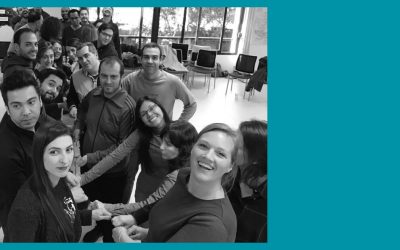Agile leadership is NOT about the leader
Agile leadership stands for team’s autonomy, collective responsibility, and flexible forms of project management.
Born out of the Agile software development approach of the early 2000s, Agility (Agile Coaching) has now spread across all business sectors, helping teams become collaborative, self-organizing, and resilient in a constant-changing environment. Frameworks at the base of the Agile method, such as SCRUM and KANBAN, can easily be applied to other areas of business and intelligence management.
By valuing individuals and interactions over processes and tools, Agile Coaching resonates perfectly with my approach to executive coaching and team building. In 2018, I was trained in Agile Coaching by UST Global. The training gave me the privilege of working in a global Telco organization, in Madrid, that was going through the process of digital transformation. Together with a great team of that consultancy company, I trained, coached and mentored individuals and teams in Agile Business Transformation.
What is Agile leadership?
In Agile, the focus is on collaboration and the self-organizing team. This approach emphasizes how people work together to find practical, appropriate solutions to the project’s challenges. In this context, the role of the commanding leader switches to the concept of the “servant leader”.
Serving, not controlling, becomes the main attribute of the leader’s actions. According to Robert K. Greenleaf, a Servant Leader “… begins with the natural feeling that one wants to serve, to serve first.”
Why you can’t escape Agile leadership
If you want your team members to make their own decisions and feel responsible whilst motivated by their newly acquired autonomy, you need to make sure, from a level of leadership, that they are not “trapped” in silos that undermine all of those agile, proactive actions.
What happens all too often in organizations (maybe not newly formed startups) that undergo a painful process of digital transformation, is that vertical silos tip to horizontal ones.
Teams may well adapt to new frameworks, communicate with a great degree of transparency, create chapters and tribes that seemingly demonstrate flat hierarchical structures, but has leadership changed?
“People never care how much you know, until they know how much you care”
John C. Maxwell
So, how can you prepare your leadership in an Agile world?
One of the greatest misconceptions of Agility is that it’s faster.
In reality, the world and context around us are fast changing. Agile frameworks are merely a flexible, adaptive way to work with fast changes and, most importantly, discover processes for continuous improvement.
“When we accept that failure is simply feedback on what we need to work on next, risk-taking becomes a lot easier”
Ron Friedman
Moving from a culture of “fear due to failure” to one of celebrating failures for the sake of learning is a huge mental hyperjump for most leaders. If you haven’t read the featured article on Success & Failure, take a peek for some interesting insights.
Let’s be fair! Being a leader in any company that is related to or pressured by the digital age is a tough cookie. Agile leadership doesn’t ask you to re-invent the wheel, however. Rather, I would say it asks you once again to go back to the basics.
The role of the leader is still vital. The leader assures the team is complete, with a full spectrum of the skills needed for the project. The leader also builds a motivating, inspiring environment that allows for team members to grow and be successful. Specially, the leader knows how to raise autonomy and collaboration among team members. For a quick exercise on a responsibility model, check our worksheet Responsibility & Proactivity.
Agile leadership is NOT about YOU
It is about the people that rely on your lead.
Your leadership style is unique to you. True! But Agile leadership brings you the opportunity to develop and strengthen valuable leadership abilities, necessary in our fast-paced, digital business context.
These are the basic pillars of leadership abilities in an Agile world:
-
Trust people to be resourceful and whole
You’ve heard it before and you’ll hear it again: your team members are your greatest asset. Fully trust that your people will make the right choices, acknowledge their own mistakes, and develop solutions. This way you allow for learning, autonomy, and progress.
-
Be available and listen actively
Being a leader has a great component of being a coach. Most of what a coach does is to listen. Actively. Really listen. This way you acknowledge the feelings and reality of the one trusting to come to you and tell you his/her story. Acknowledge that trust. Sometimes that’s all it takes. Don’t assume that action is needed on your behalf. Be humble and ask what is needed! You may be surprised how resilient your team is in resolving issues themselves with a servant soundboard.
-
Let go of your idea as soon as you had it
Being in the position of a leader may make you feel slightly more important than the team(s) that you guide. However, as soon as you sit in front of the room, you make it about you. If you take the lead, people assume you may be right. But as Steve Jobs said, he employed people because they knew what he didn’t. Lead from the back of the room; let go of your ideas. You may be right, but it’s co-creation and team effort that propels motivation and engagement.
-
Creativity is about co-creation: We are all owners of progress
In the role of the servant leader, all creation is an effort of co-creation, of aligning creative resources and ideas to solve problems and move beyond obstacles. Collaboration in this level transforms the team in a group of owners of the product and the process. Everyone is responsible, to some degree, for great ideas, and failures alike. The more you realize as a leader that it’s about the collective, the more you serve the team in achieving a collective goal, instead of bragging about individual peeks. Makes you think if the system of bonuses needs a little tweak?
-
Being wrong is a process of learning & adapting
If you read about Google, Yahoo! and other startups, you know that they allow up to 20% of their working time to be dedicated to innovation. In reality, that means dedicating time and energy to create stuff that doesn’t work (yet), hoping that one day it will bring an amazing idea. Put emphasis on yourself and others in the process of learning by adapting continuously to new circumstances. That is agility! Continuous improvement. If you want to be an agile leader this is the final hurdle to overcome.
“Change before you have to. The worst mistake is to do the right thing for too long”
John Chambers
To help you navigate through the challenges you may face at work in your leadership role, we create monthly worksheets with simple, yet hands-on 5-min and 10-min activities. Simple exercises help you get on track and stay focused at work. Take a sneak peek below.
We offer these worksheets for free!
Check our full library of practical worksheets here. In our section on Leadership, you can download this month’s Agile Leadership Worksheet, with activities to implement right away and practice every day. Browse the library to find extra exercises to improve motivation, lower stress, and increase productivity.
**Quick peek into our WORKSHEET**
_For you, if…
- You want to walk the talk of agility
- You want to increase performance & productivity
- You care
_Quickies 5min
A) Get to know your colleagues.
Building authentic relationships at work is crucial to being a great leader. Fakeness smells. Be honest. Sincerely show interest in people. When you go for coffee or lunch, share a personal anecdote or story that will most likely evoke trust. Ask your colleague or team member:
- How could I be of service to you?
- How can I help you with (the challenge they share with you)?
B) Celebrate failures!
_Take it further!
…take it further and deepen the learning by doing all the exercises suggested in our worksheet. Sign up below with your name and email to download the complete worksheet.
Always keen to know how you are getting on!
Maike

MAIKE STOLTE
Executive Coach. Consultant. Trainer. Facilitator.
Categories
Contact us

Burnout. COVID. New Normal: How to get yourself back into balance & recover!
By now, most of us share a similar feeling: we feel drained. For months now, we have been bravely facing the Covid-19 pandemic. I think it’s fair to say that it has taken its toll on us. No matter your context, you may have been dealing with the stress of the...
Relational leadership: Influence is trusting and being trusted
We are our relationships. When we foster positive relationships, we create positive environments, develop positive projects and bring positive change to the world. This power of relationships is the base of relational leadership, focused on the leader’s ability to...
Insights From Natural Leaders: With Yasmine Khater
We can always find inspiring natural leaders close to us! In this series of interviews, I’m talking to people who have touched my soul: small business owners, neighbors, friends & colleagues. Those who inspire me to spread the wisdom & insights of our common...





0 Comments